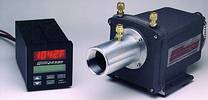

The temperature of molten metal may be measured using an infrared temperature sensor. However, installation conditions and sensor placement play a significant role in the quality of the temperature measurement. Without exception, care should be taken to avoid the following circumstances:
* Surface cooling and surface oxides. Once the metal has stopped moving, the surface will cool significantly within a few seconds due to convection heat transfer. Also, slag or dross that has formed on the metal surface acts as an insulating layer. The cooler surface temperature displayed when the surface is stagnate or covered by oxides does not represent the bulk metal temperature.
* Heavy smoke. Heavy smoke may cause a false temperature measurement. This is due to severe dilution of the infrared signal or reflections of stray emissions off the smoke and into the sensor.
* Reflections. Molten metal is highly reflective. If objects within the area of the target have a temperature that is close to the molten metal temperature, the possibility for interference from background reflections exists.
* Background interference. Sensors will sometimes have a direct view of a hot target in the background. This might happen during the measurement of small streams (smaller than the sensor target area) or when sparklers (ignited pieces of carbon that come out of solution) are present.
* Entrained slag. A significant amount of slag in the molten metal stream will cause the sensor to read low. However, small amounts of slag in the metal flow will have insignificant impact on the sensor accuracy.
Through thoughtful sensor placement, it is usually possible to eliminate all or most interfering conditions.
* Metal surface must be moving and free from oxides. It is recommended that the measurement be made during a pour, in a rolling induction pot, or in a trough after a skimmer block.
* Avoid heavy smoke. Smoke may be moderated through control of the pour rate and ventilation. The sensor's low energy threshold gain can be adjusted (a hidden adjustment) to help reduce smoke interference.
* Avoid reflections. The sensor must be located where it does not view an image of a hot object reflected off the molten metal stream. Hot refractory objects like launders, lances, furnaces, and container walls are common reflection sources. Thoughtful sensor placement or shielding of background interference often suffices.
* Avoid a hot background and sparklers. If the sensor's field of view is larger than the target diameter, the background temperature must be cool. Sparklers often subside after the receiving vessel's temperature stabilises.
* Avoid entrained slag.
Interfering conditions are not always avoidable. Fortunately, the Williamson PRO Series sensors can identify valid conditions. For example, smoke will decrease the signal strength (emissivity) value while presence of oxides, reflections, or sparklers will increase the signal strength value.
For installations where interference is unavoidable, the Williamson PRO Series sensors may be configured to report only those readings identified to be valid.
1. Set Alarm 1 and Alarm 2 parameters to signal strength.
2. Set Alarm 1 setpoint to the low emissivity limit and set Alarm 2 setpoint to the upper emissivity limit. (The appropriate emissivity values vary by metal.)
3. Run temperature output signal through Alarm 1 and Alarm 2.
4. From the alarms, run the output signal to a secondary display or data acquisition system.
With this setup, output will only be transmitted when the reading is valid.
When heavy smoke and either excessive oxides, reflections, or background interference are present at the same time, the signal strength changes may offset each other. In these situations, the PRO Series sensor may not be able to correctly identify the improper measurement conditions. For measurements where heavy smoke, oxides or background interference are likely to occur concurrently, additional signal conditioning may be required to identify valid temperature readings.
Williamson is marketed and supported in southern Africa by Temperature Controls.
| Tel: | +27 11 791 6000 |
| Email: | [email protected] |
| www: | www.tempcon.co.za |
| Articles: | More information and articles about Temperature Controls |

© Technews Publishing (Pty) Ltd | All Rights Reserved